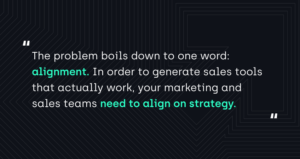According to SiriusDecisions, approximately 60% to 70% of content produced by marketing organizations is unused by sales. The American Marketing Association also estimates that salespeople spend over 30 hours per month searching for or creating their own marketing collateral.
So, why are marketing departments creating this stockpile of materials that sales decline to use? And why do so many salespeople take a “do it yourself” approach? The problem boils down to one word: alignment. In order to generate sales tools that actually work, your marketing and sales teams need to align on strategy. Marketing should offer a verifiable process that maps out what is really working. This process will ultimately determine what customers really care about and address the internal hurdles that they need to overcome. The good news is; you can drive this effort from within your marketing team by following a handful of simple steps.

FIRST
Get Clear on the Sales Process
Even though sales is the other side of marketing’s coin, the two teams have very different approaches for meeting their goals. Your sales force may think that all they need is a one-pager targeted to a specific persona in order to close a deal. Marketing, meanwhile, might be working on an in-depth nurture program that targets the same type of buyer.
Sales tends to be reactive, thus they will quickly write up what they need and jump into the sales process. Unfortunately, quick-and-dirty sales tools produced off-the-cuff can lack key aspects of branding and could result in the dissemination of incomplete, inconsistent or even inaccurate messaging.
In order to generate marketing collateral that sales will use—rather than bypass—it’s critical to first align your sales and marketing teams so that marketing can anticipate the needs of the sales organization. As a marketer, you have a deep understanding of your products and services, but how fluent are you in your sales team’s process?
SECOND
Understand efficiency vs. effectiveness
At its core, marketing departments are driven by efficiency. Marketing leaders seek the biggest impact for efforts and dollars spent. Both the return on investment and return on volume are key metrics, so their primary focus is on being efficient, and deciding how and where to get the most bang for the buck.
Sales departments, on the other hand, are driven and rewarded based on effectiveness. Salespeople either hit quota or they don’t, and their reputation, their livelihood – and when the rubber meets the road – their very jobs are dependent on that one thing. So their ultimate goal is to be effective in their efforts so that they hit their number.
In order to create sales tools that are appealing, on-target and timely, so that sales feels supported by marketing’s efforts, it’s important to know not just what sales needs, but why they need it and when they’ll use it. Then both marketing and sales are working together toward their goals of being efficient and effective.
THIRD
Talk to your brand advocates
Within every buyer ecosystem, there exists a set of customers who will gladly share their success stories in support of your brand. They understand the benefits of your products or services, and they know why they chose you over your competitors. The valuable information that they can provide will help you take some of the guesswork out of your messaging.
When you talk with your brand advocates, look for common objections or stalling points in the sales cycle that could have been avoided if your sales team had the right message delivered in the right way at the right time. Ask them what led them to their decision to purchase, and if any collateral in particular influenced their choice. Drill down into the messaging that had the biggest impact. Also, take time to fully define each of your brand advocates, and compare them to your defined personas. Many times, you can strengthen your persona definitions by understanding your advocates.
If possible, continue this same process with those in the “loss” column—prospects who didn’t become customers. Find out what prevented them from signing. Dig for the root of their objections by determining why they chose another brand over yours, find what was missing in your messaging, and figure out how you could strengthen your collateral in a way that might have overturned their objections. Your ultimate goal is to discover the sales tools that are working and which ones can be revised or discarded.
FOURTH
Create your (synchronized) sales tools
One of the biggest communication divides between sales and marketing revolves around messaging. Given to their own processes, marketing teams prefer to generate high-level, universal messaging that appeals across a wide array of prospects. Sales, on the other hand, prefers targeted messaging that speaks directly to the customer of the day in order to quickly close a deal.
The best tools, however, tend to sit somewhere in the middle, providing enough high-level messaging that your overarching strategy is supported, but targeted enough that they appeal to a specific buyer persona. For example, a CTO is going to be more interested in the impact your technology solution will have on their organization in terms of downtime, configuration, management and maintenance. A CEO may respond better to a quick video or infographic. However, the CFO will be interested in an ROI calculator that justifies the expense of your solution. Accounting may want to see charts or graphs. All of the decision makers need to know what your product is, what it does, and how it solves their problems, but they are going to want to see the information presented from a different angle. So, look at your current sales tools and determine the best methods to overcome specific objections from decision makers with different agendas.
That’s where synchronized sales tools come into play. When marketing is aligned with sales, and they understand each other’s goals, marketing is able to provide a portfolio of tools that supports sales at each touchpoint of the deal. A concise set of synchronized tools provides the high-level information that defines your products and services, but each individual piece of collateral gives a single buyer persona the answers to his or her specific questions. Five to seven sales tools will often work just as well as 20. Sales gets their pin-pointed messaging needs satisfied, and you are assured that the tools that sales uses are properly branded and contain complete and accurate messaging.
Also, remember that the customer will be using the tools that you’ve created to make their case internally to different groups. They shouldn’t have to modify these tools to do so. Instead, the sales team needs to provide a synchronized set of tools to overcome potential objections that is totally aligned with the customer’s needs.
When you provide synchronized tools, you will see some pretty amazing results:
- Your sales team will be satisfied, reducing their tendency to create their own tools.
- Salespeople become trusted advisors to potential buyers due to consistency in messaging. The tools will help make them valued participants in the customer’s internal sales process.
- Your marketing collateral will empower the seller and the buyer, which can strengthen your posture in your industry.
- The sales process will become much more predictable.
FIFTH
Maintain the momentum
Once you’re seeing better results with your synchronized sales tools, your marketing team should regularly check in with sales to review ongoing and upcoming needs. When you work together as a cohesive unit, marketing can proactively create targeted tools to meet evolving sales requirements. Additionally, you’ll be able to evaluate low-performing tools through structured analysis and react by retargeting your messaging.
The process of creating synchronized sales tools can feel daunting at the start. It takes time to gather data, align with sales, analyze existing tools and provide a concise set of collateral that covers the entire sales process. However, the ultimate returns will more than justify your efforts. Once you take a deeper dive into the needs of both salespeople and prospects, you’ll have far better insights into what each group needs. Your continuing effort becomes an act of keeping your finger on the pulse of sales, and then predicting the changes you’ll need to make to keep your tools up to date.

Just remember, when you focus on creating better instead of more, your better solution will ultimately deliver more. In the case of creating synchronized sales tools, you will benefit from a more harmonious sales and marketing relationship, a higher conversion rate and a more profitable bottom line.

